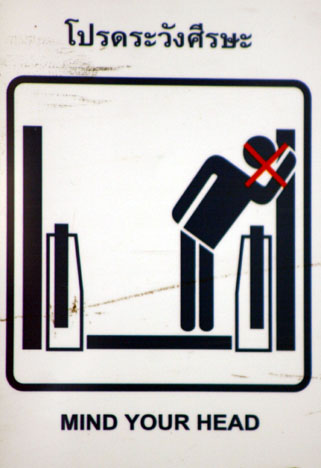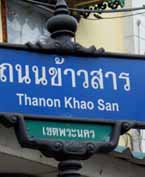Tags

If you can not master using the BTS in Bangkok, which has been designed with the directionally challenged Thai in mind, then Darwin says your family line should end with you.
When I was a young juvenile delinquent, the school I was supposed to be attending held a assembly to warn us all of the dangers of the bay area’s new light rail system’s third rail. BART was still under construction at the time, but nearing completion and the powers that be wanted to avoid turning the local kids into crispy critters. I doubt Thailand took the same steps when the BTS was gearing up to go operational. The Thai attitude toward personal safety is more about fate than prevention. Or maybe they just understand better that Darwin had it right.
A better waring in the early days of construction might have been about the elevated portions along Sukhumvit crumbling and falling down onto pedestrian’s heads. But then that might have led to actually blaming someone for that little disaster, something which is to always be avoided in Thailand where human life is cheap, but reputations are greatly cherished. Now with the system providing a quick and cheap transpo option for citizens and touri alike, you’ll never here warnings like ‘Mind the Gap’ that the Brits are so fond of either, but you will see security guards at every station in Bangkok watching out for your well-being. Well, okay they are there to enforce rules against smoking and eating and to provide employment for the connected’s minor relatives, but if it makes you feel better you can pretend your safety is part of their responsibilities.
Bangkok’s BTS, or Skytrain, is a boon to tourists, it goes to the majority of places within the city that you’ll want to visit. It is cheap, clean, safe, and a great way to avoid the city’s notorious 24/7 traffic gridlock. Using the system is a breeze, once you’ve mastered the unique Thai cultural twists involved. For newbies to the city, especially those who have not used a light rail system before (and where in the hell have you been living?) I’m gonna cover the basics in this post. I’ll also be following up with posts highlighting various stations, their surrounding neighborhoods, and why you should consider those stations worthy of a stop. For now, let’s just concentrate on getting your ass on a train.
Your first opportunity for using the Skytrain is at Bangkok’s airport, there is a rail link, recently opened, that connects to the regular lines in town. Kinda, sorta. If after flying a dozen hours to get to Thailand you really want the hassle of navigating your way through the system, and then navigating your way through Bangkok’s bustling streets pulling your luggage along behind you while you search for your hotel, go for it. But if you are that cheap, you don’t deserve my assistance so you are on your own. Hopefully your holiday in Bangkok is longer than the two days it’ll take you to make it to your place of lodging.
Taxis are cheap in Bangkok. Tuk tuk are ubiquitous and a good transpo option if you need the experience or are only travelling a few blocks and value neither your safety or your life. Nine times out of ten, the BTS will be your best transpo option, so that means picking a hotel convenient to one of its stations. This is easier said than done. Bangkok’s hotels have figured out that touri like to be by the BTS so every one of them advertises they are within walking distance. So is the summit of Mount Everest.
If you speak Thai you can avoid falling for their lies. ‘A short stroll’ is Thai for a 30 to 45 minute walk in the blistering noonday heat. Don’t be confused by their use of the metric system either: ‘500 meters from Chong Nonsi Station’ computes to 1.8 miles. And any hotel that has ‘free tuk tuk service to the BTS station’ – and most now do – is telling you that even they think it is too far for you to be walking (note that you are on your own when trying to get back to the hotel).
This is probably a good point to mention BTS station names. Their English version is, like tipping bar boys, a matter of ‘up to you’. Even the signage at the station will use a variety of spellings. Chitlom can also be spelled Chit Lom. As well as Chidlom and Chid Lom. Listing all of the other possible spellings would be worthy of a blog of its own so instead my advice is that if it the spelling is close to looking familiar, assume it’s the station you want. If it is not, well, discovering the unknown is part of what international travel is all about.
Most hotels and hotel websites rely on Google Maps these days, which is a good thing ‘cuz map and Thais go together like Tom Cruise and a lasting, loving marriage. Take time to plot your prospective hotels’ locations as it relates to a BTS station. Anything within a true five minute walk is good. Anything further away means you’ll be grabbing a taxi instead after your first hour long hike between your temporary home at the BTS.
Familiarizing yourself with your local station is a good idea. Almost every station has a set of escalators going to both the ticketing floor and the floors where you board the trains. They are well-hidden and never near the entrance you’d normally use. If you are lazy or hate stairs, pinpointing where the escalators are can make your life much more rewarding.
You’ll also want to familiarize yourself with the stairs leading out of the station as every station has about a dozen different exit points. Most will take you in the exact opposite direction of where you want to go. Some will lead you to those well-hidden escalators, but since they go up and not down you’ll be stranded when you do find them. And other still will prove that despite what some may think, Thais do have a sense of humor. For example, one at the Chong Nonsi Station leads you down and drops you into the middle of a busy street. No, I mean right smack dab in the middle of the boulevard, not onto a handy sidewalk.

Stairs have their use. Getting to public transportation because you were too lazy to walk in the first place isn’t one of them.
If you are unsure of which exit to use at any given station, watch where the mob of locals head. And then walk in the opposite direction. Thais lean toward collectiveness, which means as a mob they like to play lemming. Wherever they are headed, it is not somewhere you want to go, so strike off on your own. The best people to follow are elderly farang with a hot young bar girl under arm. Most of these guys have visited Bangkok so often they know the city and its systems like the back of their hand. Hell, most know the place like the butt crack of the whore they just bought for the day, which most of the other farang in town know quite well too.
Being familiar with your neighborhood BTS station will do you no good on your first visit unless you also know where it is you plan on going. As soon as you make it into the station you’ll need to purchase a ticket, and the price is determined by where (not how, mind you) you plan on getting off. Fortunately, there is a map of all the BTS stations on both lines – not drawn by a Thai – right next to every ticket machine. The map also identifies the fare for each station. It is a wonderfully simple graphic easily understood regardless of the language you speak. So the only people who will have trouble figuring out the fares are the locals.
Next to the maps are the ticket machines. They take coins. Which you just got rid of by dropping them in the beggar’s cup of that poor Thai lady with the little baby cradled in her arms that tugged at your heart strings as you were climbing the stairs to the station. Both the destitute woman and the baby, by the way, arrived at the station from different routes with the baby taking the longer trip in from Burma. They’d have been good people to ask for directions.
Any where else in the world a machine would be provided to change your money into coins. But this is Thailand. Instead, some distance away, will be a glass enclosed office where a live Thai is stationed to break down your bills for you. This involves using math, so good luck with that. Some stations have recently installed ticket machines that take bills. Avoid them. They always have the longest lines (comprised of locals trying to figure out why the bill slots won’t accept coins), and frequently don’t like the bill you try to feed them.
Coins in hand, back at the ticket machine, the station you want to travel to is identified on the map with a fare designation such as ‘6’. This is the number you punch in at the ticket machine. It in turn tells you how much baht to insert. After refusing several of your coins for the hell of it, the machine will issue you a ticket. Try not to lose it.
At the turnstiles you insert your ticket into a slot located at the front of the turnstile, and take it back from a slot on top. This opens the gate for you to pass through. The machine senses your passage, and shuts its gate behind you. If you spent the day shopping and are loaded down with bags, the machine will let your bags through and shut before you make it through yourself. Or the other way around if your bags trail you through the turnstile. You need to instead hold them above the machine to each side of you as you pass through the gate. I have to assume those of the typical size of a Pattaya expat have a similar problem getting themselves and either their stomach or ass through the turnstiles too.

If your destination is still too far for walking, you can always grab one of the motorcycle taxis huddled by every BTS station. Pick the right driver and you won’t have to go to that massage shop after all.
Now you need to figure out which set of stairs to climb to get to the train you want. Except for at transfer stations like Siam, there are only two trains, going in opposite directions of each other. So of course there are a minimum of six separate sets of stairs. The set the furthest from you will be an escalator carefully placed to require the same amount of effort in reaching them as you will save by riding the escalator instead of climbing the stairs.
The multiple stairs thingy may mean you are confused about which direction to walk in so as soon as your pass through the turnstile it’s a good time to practice a time honored Thai cultural custom and come to a full stop blocking those behind you while you decide where to go, what to have for lunch, and where you should spend your next ten years’ worth of holidays.
Knowing the locals would never find compass points of use, the BTS system is designed to designate direction using the name of each of its end stations. So, for example, instead of heading east, you go ‘Mo Chit.’ There is a map (again not designed by a Thai) just inside each station that lists every station on each line that is serviced by the station you are at. Once you have learned the end station names, this is an easy system to use. Except for that they keep adding stations. So what was the end station, and the designation used for the direction that train travelled, gets changed when a new station opens. Hopefully this does not happen while you are still on board.
Trains run every 15 minutes, or on Thai time, whichever comes first. Regardless, there is never a very long wait. At the edge of the boarding platform there are large areas color coded to tell you where to line up for boarding. As soon as you get to the platform, grab the front spot closest to the platform’s edge so that you get a good seat when you board. You will note the locals do not line up, allowing the guests to their country to take the premium waiting spots instead. No problemo. As soon as the train arrives they will all push forward and slip in front of you.

You can assume your previous life made Mother Teresa look like a whore if this is ever the sight you are presented with when boarding the BTS.
The same markings have a set of arrows showing the direction for people disembarking to use, and those embarking to follow to keep the masses from trampling each other. But the arrows are in English and so are not understandable to the local populace. You are supposed to allow those getting off the train to do so before you board, but much like with the line you tried to form for boarding, this is a suggestion, not a royal decree, and as such is ignored by Thais.
Once you are on board you’ll find that the BTS these days closely resembles a sardine can. It is polite to push and shove your way inside so that you are not standing and blocking the door. This would make it easier for your fellow passengers to disembark at the next station, but the doors on the trains tend to open on opposite sides from one station to the next, so the out-of-the-way spot you found will soon become the spot everyone wants to use to get on or off the train.
Occasionally you’ll find a near empty train when you board. This only happens if your karma is exceptionally good. You can grab whatever seat you fancy. Note there are seats reserved for monks and the elderly, but you can ignore their intended use like everyone else does. Monks don’t use the Skytrain and few of the elderly are capable of climbing the stairs to get to the trains. Elderly farang, by the way, do not count as they are beneath consideration, so don’t expect any local to offer you his seat. Unless he’s a bar boy. Then he will offer you his seat if a large enough tip is involved.

Despite what you may think, the poles erected inside of the Skytrain cars are not intended for locals to use to practice their job skills.
As your train fills you’ll notice no Thai will want to sit next to you. Do not let this bother you, even though they are acting as though you are a fat, hot, sweaty, disgusting foreigner who stinks and whose motives are questionable where locals are concerned. This is because you are a fat, hot, sweating, disgusting farang whose motives are questionable where locals are concerned. Enjoy the extra space while you can because the car will soon become so full someone will push an unfortunate local into the empty seat next to yours and, if he is male and under the age of 40 you’ll begin fantasizing of all the things he’d be willing to do for 500 baht.
Like time, the BTS waits for no man. You need to be up out of your seat and near the doors when your train pulls into the your disembarkation station. When the doors slide open, all the locals waiting to board will push you further into the train in their effort to grab the seat you just vacated. With luck, there will still be enough time for you to squeeze your way off the train before the doors slam shut. If you made it off the train successfully follow the mob of locals down the closest set of stairs and then like most of them come to a complete stop while you decide which exit to use. Surprisingly, there are well placed signs at ceiling height that show you which direction each exit is and where that exit leads. You’ll notice most of these signs are only in English, but that’s because printing them in Thai would be a pointless use of ink because they are, well, directions.
To get out of the station you will have to feed your ticket through the turnstile once again. Your ticket is a single use fare so after feeding it into the machine it will not be returned to you. So much for your cheap souvenir. Most touri destinations are if not connected to the stations serving them, then damn close. However, some of the more culturally significant spots, such as the soi 11 massage parlors, are still a bit of a distance away. There are always a group of motorcycle taxis available for you to reach your final destination (which, since riding a motorcycle in Bangkok is an iffy proposition might just be in fact your final destination).
Related Posts You Might Enjoy:







I typically stay at the Siri Sathorn which is 10-15 minutes walk to Saladaeng BTS. In nice weather it’s not so bad. But they do also have a shuttle van. So I wouldn’t totally rule out a place that is a little farther from the train. The MRT is a little nicer but doesn’t go to as many useful places.
Though most relying on the BTS do not want to walk any further than required, I’d agree Glenn that there are some nice hotels with bad locations that should not be immediately discounted. I like the MRT but use it seldom, mostly for the reason you stated. It is the best of the two to get to the weekend market though.
Now you have to write about the crazy cabbies as well! With all the different colors!
The only colors I ever see them in is red Paul.
🙂
But a ‘how to’ on taxis could be a fun post!
Don’t forget the pink, white, green and yellow ones!
A ‘how to’ use the taxi service in Pattaya would be really helpful. Even my Thai friends in Bkk are unusre how it works! It’s easy enough to get on one of the ‘trucks’ at the coach terminal and get to Dongtan Beach but getting one back from the beach to the coach terminal is a whole lot harder!
Sorry John, Pattaya is not my beat!
That’s one of the things that does not fascinate me about that town: no taxis, no tuk tuks . . .
If it’s a consolation for you: I still have problems with the Pattaya baht-bus system. I manage to to from the bus station to Sunee without changing, but the other way I always need to change at Dolphin roundabout. If you ask where they are heading, they assume you want to hire them and quote an unreasonable price.
I love the BYS Skytrain! It is extremely clean, well-run, efficient, safe and air-conditioned. I wish we had a similar system in London as opposed to the filthy dirty, overcrowded, airless, smelly and unreliable underground system we have to use here!
lol
Gee the NBC commentators seem to be quite taken with the tube!
hey, rule of thumb: a meter is a tad more than a yard or 3 feet – so 500 meters is about 1/3 of a mile. Or am I crazy or just a metric challenged American.
Thanks Don, but my rule of thumb is that if isn’t measured in inches it doesn’t really matter anyway.
🙂
get a rabbit card… from the live Thai human behind the glass window… cost 100 bhat… saves the trouble of purchasing single trip tickets…
But then what do you do with all those damn coins that keep filling up your pockets?
🙂
Good tip though Andi, saves the frustration of having a ticket machine keep rejecting the coins you feed it too.
drop them coins into the donation boxes… seen them at most BTS stations after the ticket gantries… or any donation boxes at Wats…
or hand them to your boy-de-jour… they have purses to keep them coins… then be a cheapskate and ask the boy to pay for drinks or stuff that cost 20 bhats with those coins… hee he…
“then be a cheapskate and ask the boy to pay for drinks or stuff”
Uh, oh. I see a Pattaya in your future . . .
🙂